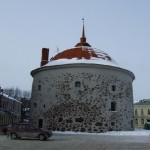VYBORG. Round Tower
Tower by the Cattle-driving gates. One of the most interesting places of note in Vyborg – the Round Tower. It is located on the Market square where in XVI century a wall stood with towers surrounding the city like a circle of stone. And in one of its towers – the Cattle-driving one – there were entrance gates, through which the city-dwellers drove their cattle out to pastures. This section of the wall was the most vulnerable in case of invasion; therefore, in XVI century, a question arose of constructing two artillery towers near the gates that would flank entry into the city and defend its ageing walls.
Construction was underway from 1547 till 1550. Famous Swedish fortifier Hans Bergen designed the new building. As for a second round tower, it was never erected. Towers of that epoch strongly differed from their predecessors – first of all by their big sizes and excellent solidity. The thickness of the walls of the rondel – the Round Tower – reaches up to four meters (13 ft). Even though the tower is called “round,” its plan does not quite match the exact circle. There is a legend, according to which governor-general of Vyborg Eric Fleming considered the rondel founded by the architect very big, and Bergen had to urgently straighten the lines. That is why on one side the tower’s wall seems to be a little flat. The people called this construction a ram’s prison. Town-dwellers often left their cattle right on the earthworks overgrown with grass, which was strictly prohibited. The little sheep that “violated the law” were locked by the city guards in a gallery between towers until careless owners paid the fine.
One of the bloodiest story of Vyborg is related to the Round Tower. In 1599, in Sweden a serious struggle for the throne was in full swing between officially crowned ruler Sigismund and his uncle Duke Charles. Charles had great influence in the army and turned his claims for the throne into a real war. Sigismund was forced to flee to Poland, and Charles began to persecute his supporters. Just like in other Swedish castles, carnages occurred in Vyborg. Charles’ soldiers beheaded the most influential city-dwellers in public including town major Arvid Tavast. The heads of the executed were brought from the site of carnage to the Round Tower and put there on iron rods for all to see. This event that took place on 30 of September of 1599 is remembered as “the Vyborg massacre.”
In 1609, after another military conflict between Russia and Sweden in the Round Tower a very burdensome and inconvenient for Russia Swedish Tract was signed, under the terms of which Sweden annexed Korela (today’s Priozyorsk). By XVIII century the tower lost its defensive meaning. In the documents of those times it is called “Petrovskaya” or “Peterburgskaya.” For many years it was desolate; then it was used as a storehouse. The city authorities tried to tear it down twice but both times the city’s community interfered to rescue the old rondel.
Only in 1923, the Round Tower received a new life as it became a historical restaurant and a place of meetings of a Technical Club – a union of Vyborg’s architects. In the WWII years, the building was almost not harmed. In 1940, in the “three-storied stone tower” a Museum of local lore was opened; it existed several months. In 1970s, restoration works were carried out in the tower, and a restaurant, which successfully works to this day, was opened there again.

